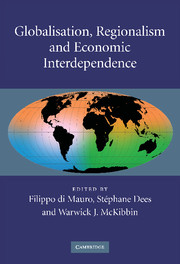Book contents
- Frontmatter
- Contents
- List of figures
- List of tables
- List of contributors
- Preface
- Introduction
- 1 International linkages in the context of global and regional integration
- 2 Trade integration of the central and eastern European countries and China: has it reached potential?
- 3 Patterns and determinants of production fragmentation in world manufacturing trade
- 4 Going global: trade, internationalisation of production and domestic performance of euro area firms
- 5 Globalisation and the trade channel in the euro area
- 6 Gauging the labour market effects of international trade openness: an application to the US manufacturing sector
- Index
- References
6 - Gauging the labour market effects of international trade openness: an application to the US manufacturing sector
Published online by Cambridge University Press: 02 September 2009
- Frontmatter
- Contents
- List of figures
- List of tables
- List of contributors
- Preface
- Introduction
- 1 International linkages in the context of global and regional integration
- 2 Trade integration of the central and eastern European countries and China: has it reached potential?
- 3 Patterns and determinants of production fragmentation in world manufacturing trade
- 4 Going global: trade, internationalisation of production and domestic performance of euro area firms
- 5 Globalisation and the trade channel in the euro area
- 6 Gauging the labour market effects of international trade openness: an application to the US manufacturing sector
- Index
- References
Summary
Introduction
The increasing trade integration of emerging markets, in conjunction with rapid technological change, has exerted significant pressures on the labour markets of developed economies in recent decades. It has been argued that increased trade openness has led to the attrition of low-skilled jobs in certain sectors to developing countries, with growing imports of labour-intensive manufactured goods from developing countries accompanied by a fragmentation of production across borders. At the same time, technological change has probably contributed to a sectoral reallocation of production biased against primarily low-skilled workers in developed economies. These two phenomena have become progressively intertwined, given the role of trade in technology diffusion and adoption both directly (e.g. through imports of capital goods or convergence in technical efficiency) and indirectly (through pressure on firms exposed to trade to innovate).
Regional integration agreements may have amplified the effects of trade on labour market developments as such agreements both create and divert trade, while also implying scale and competition effects that lead to changes in country specialisation (see, for instance, Venables, 2001). In the case of the United States, the North American Free Trade Agreement has led to such regionalisation of trade, and has therefore probably been important in shaping labour market developments, particularly in those sectors most open to trade. Naturally, the impacts of trade openness are likely to be strongest in those sectors most subject to competition, either domestic and foreign – that is, those producing traded goods, such as the manufacturing sector.
- Type
- Chapter
- Information
- Globalisation, Regionalism and Economic Interdependence , pp. 126 - 159Publisher: Cambridge University PressPrint publication year: 2009



